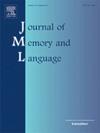任务目标制约了人际协调过程中眼球运动和言语的一致性
IF 3
1区 心理学
Q1 LINGUISTICS
引用次数: 0
摘要
协作任务绩效被认为受益于相互作用的个体之间的人际协调。关于语言使用和社会行为的突出观点,包括交互式对齐模型(IAM; Pickering & Garrod, 2004),通过建立需要监控合作伙伴观点的任务(例如,在路线规划中)来支持这一观点,提出行为对齐使概念收敛。然而,对齐在需要互补性的任务中的作用(例如,联合视觉搜索期间的“分而治之”策略)仍未得到充分探索。我们通过操纵任务目标(路线规划与视觉搜索)来解决这一差距,让40对夫妇完成了涉及地铁地图的10个试验,同时他们的眼球运动和语言被共同记录。我们使用交叉递归量化分析(Cross recurrent Quantification Analysis, CRQA)来检验伴侣的眼睛注视和单词序列之间的时间关系,生成揭示相似性和动态耦合的度量。在一系列CRQA指标中,双性恋者在路线规划中比视觉搜索表现出更多的注视对齐。在整个实验过程中,注视方向也各不相同,与准确性的关系也不同:在视觉搜索中,在实验后期,注视方向越准,表现越好。在语音中,路径规划导致单词序列更长、熵更高,但总体递归率低于视觉搜索。这一发现表明,这两种模式以一种补偿方式组织起来,以支持不同的任务需求。这些结果支持了一个比IAM更通用的理论框架,其中交互式对齐作为对任务目标的动态适应的结果而出现。总的来说,任务目标限制了人们如何协调行为,并提供了协作伙伴如何分配其多模式贡献的见解。本文章由计算机程序翻译,如有差异,请以英文原文为准。
Task goals constrain the alignment in eye-movements and speech during interpersonal coordination
Collaborative task performance is assumed to benefit from interpersonal coordination between interacting individuals. Prominent views of language use and social behavior, including the Interactive Alignment Model (IAM; Pickering & Garrod, 2004), support this view by building on tasks that require monitoring a partner’s perspective (e.g., in route planning), proposing that behavioral alignment enables conceptual convergence. However, the role of alignment in tasks requiring complementarity (e.g., a “divide and conquer” strategy during joint visual search) remains underexplored. We address this gap by manipulating task goals (route planning vs. visual search) as forty dyads completed ten trials involving subway maps while their eye movements and speech were co-registered. We used Cross Recurrence Quantification Analysis (CRQA) to examine the temporal relationships between partners’ eye fixations and word sequences, generating measures that reveal similarity and dynamic coupling. Dyads exhibited more gaze alignment in route planning than visual search across a range of CRQA metrics. Gaze alignment also varied across the trial and related differently to accuracy: in visual search, greater alignment late in the trial predicted better performance. In speech, route planning prompted longer and more entropic word sequences, but lower overall recurrence than visual search. This finding suggests that the two modalities organize in a compensatory fashion to support distinct task demands. These results support a theoretical framework more general than IAM, in which interactive alignment emerges as a consequence of dynamic adaptation to task goals. Overall, task goals constrain how people coordinate behavior and offer insights into how collaborating partners distribute their multimodal contributions.
求助全文
通过发布文献求助,成功后即可免费获取论文全文。
去求助
来源期刊
CiteScore
8.70
自引率
14.00%
发文量
49
审稿时长
12.7 weeks
期刊介绍:
Articles in the Journal of Memory and Language contribute to the formulation of scientific issues and theories in the areas of memory, language comprehension and production, and cognitive processes. Special emphasis is given to research articles that provide new theoretical insights based on a carefully laid empirical foundation. The journal generally favors articles that provide multiple experiments. In addition, significant theoretical papers without new experimental findings may be published.
The Journal of Memory and Language is a valuable tool for cognitive scientists, including psychologists, linguists, and others interested in memory and learning, language, reading, and speech.
Research Areas include:
• Topics that illuminate aspects of memory or language processing
• Linguistics
• Neuropsychology.

 求助内容:
求助内容: 应助结果提醒方式:
应助结果提醒方式:


